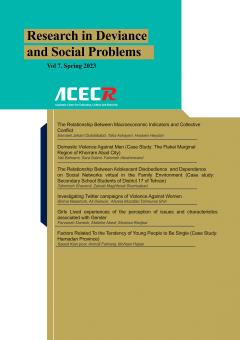Girls Lived experiences of the perception of issues and characteristics associated with Gender
Subject Areas : Research on Iranian social issues
Parvaneh Danesh
1
*
![]() ,
maliheh abedi
2
,
morteza ranjbar
3
,
maliheh abedi
2
,
morteza ranjbar
3
1 - Associate Professor of Sociology Department, Payam Noor University, Tehran, Iran.
2 - PhD Student, Department of Sociology, Payam Noor University, Tehran, Iran.
3 - PhD Student, Department of Sociology, Payam Noor University, Tehran, Iran.
Keywords: Girlhood, lived Experience, Gender Stereotypes, Discrimination and gender.,
Abstract :
Perception and experience of gender as an established pattern can play a significant role in individuals' social and educational actions. This study focuses on exploring the lived experiences of female students from childhood. The research method employed is qualitative with a phenomenological approach. The sample consists of seventeen female students from Tehran. The sample size was determined based on theoretical saturation principle. Data collection was done through semi-structured interviews, and data analysis was conducted using thematic analysis. After gathering the data, the narratives of the students regarding their experiences of girlhood were coded and categorized. Three main themes emerged from the interviews, which further yielded nine sub-themes and twenty-three concepts during the analysis. The main themes include femininity traits, girlhood issues, and girlhood agency. The sub-themes encompass exclusive traits of girls, gender differences, being a good girl, gender discrimination, gender perspectives, gender stereotypes, changing attitudes, family role in issues, and girlhood strategies. Examining the lived experiences of girls reveals that although the examined samples reproduce some of the common emotional and behavioral characteristics associated with girlhood, the students' narratives indicate that they face limitations and deprivation in society due to their gender. Moreover, they feel a sense of injustice and discrimination in their social and daily lives. The students under study express dissatisfaction with the societal misconceptions about girls and demand more agency and empowerment for girls in society.
بخارایی، احمد (1394) «تحليلي بر عوامل فرهنگي- اجتماعي مؤثّر بر نابرابري جنسيّتي (مطالعۀ زنان متأهل ٢٠ تا ٤٩ سالۀ شهر اصفهان)»، فصلنامۀ مطالعات توسعۀ اجتماعي- فرهنگي، سال چهارم، شماره 3، صص 59-٨٢.
پین، مایکل (1394) فرهنگ اندیشه انتقادی، از روشنگری تا پسامدرنیته، ترجمه پیام یزدانجو، تهران، مرکز.
دهنوی، جلیل و سعید معیدفر (1384) بررسی رابطه احساس نابرابری جنسیتی و انگیزه تحرک اجتماعی در دختران دانشجو، مطالعات اجتماعی روان شناختی زنان، سال 7 دوره 3، صص 51-75.
رئوف ملایری، مریم و دیگران (1397) «نقش خانواده و مدرسه در شکلگیری هویت جنسیتی دختران»، آموزش بهداشت و ارتقای سلامت، سال ششم، شماره ۳، صص 302-۳۱۱.
شریفی، فاطمه و دیگران (1398) «بررسی اثربخشی مداخلات تربیتی بر هویت اخلاقی دختران 14-18 سال؛ با تأکید بر چالشها و محدودیت پژوهشنامه اسلامی زنان و خانواده»، سال هفتم، تابستان، شماره 15، صص 57-75.
علویان، ریحانه سادات (1394) «انیمیشنها، فضای مجازی و هوّیت جهانی (مطالعه موردی: وبلاگهای دختران ایرانی)»، مجله جهانی رسانه، سال دهم، شماره 1، صص 1-16.
فليك، اووه (1388) درآمدي بر تحقيق كيفي، ترجمة هادي جليلي، تهران، نشرنی.
فيروزآبادي، سيد احمد و عليرضا صادقي (1392) طرد اجتماعي، تهران، جامعهشناسان.
قادرزاده، امید و دیگران (1396) «بازسازی معنایی تجربه زیسته دختران از تجرد زن در توسعه و سیاست»، پژوهش زنان، سال پانزدهم، شماره 3، صص 403-426.
گيدنز، آنتوني و كارن بردسال (1386) جامعهشناسي، ترجمة حسن چاووشيان، تهران، نشرني.
محمدی اصل، عباس (1396) برساخت اجتماعی جنسیت، تهران، گل¬آذین.
محمودي، وحيد و قاسم صميمي¬فر (1384) «فقر قابليتي»، رفاه اجتماعي، سال چهارم، شماره 7، صص 9-32.
هال، استوارت (1393) درآمدي بر فهم جامعة مدرن (اشكال اجتماعي و فرهنگي مدرنيته)، ترجمة كاظم فيروزمندي و ديگران، تهران، آگاه.
يعقوبي، علي (1393) نظريههاي مردانگي، تهران، پژواك.
Flotten, T. (2006) “Poverty and Social Exclusion: Two Side of the Same Coin”?.
Fernandez, O (2014) “Training or social exclusion: competences for the social inclusion of groups at risk”, Procedia- Social and Behavioral Sciences 132 (2014), PP 154-159.
Hardy, S. a., & Carlo, G. (2005) Identity as a Source of moral motivation. Human development, 48, 232-256.
Kelly, M., Inoue, K., Barratt, A., Bateson, D., Rutherford, A., & Ritchers, J. (2016) Performing femininity: Female agency and role in sexual life and contraceptive use-a qualitative study in Australia. Culture, Health & Sexuality, 19 (2), 240-255.
Longmore, M.A. (1998).Symbolic Interactionism And The Study Of Sexuality. Journal of Sex Research, 35 (1), 44-57.
Piorier, Emma, "The Girl House Project: Narratives of Girlhood and Building a Site of Analysis" (2020) Gender & Queer Studies Research Papers. 4. https://soundideas.pugetsound.edu/genderstudies_studentresearch/4.
Silver, H. (1994) “Social exclusion and social solidarity”: three paradigms. International Labour Review. 133, PP 531-78.
Shea, M., Wong, Y., Wang, S., Sherry Wang, S., Jimenez, V., Hickman, S., & LaFollette, J. (2014) Toward a constructionist perspective of examining femininity experience: the development and psychometric properties of the subjective femininity stress scale, Psychology of Women Quarterly, 38 (2), 275–291.
Van Wyk, Sherine B. (2015) "It’s hard work to be a girl’: Adolescent girls’ experienes of girlhood in Three low-income communotes in south, Thesis (PhD)--Stellenbosch University.
Zajdow, G. (2007) The gender order. in mllCti sociology: an introduction to Australian society, Sydney: Allen & Unwin.
